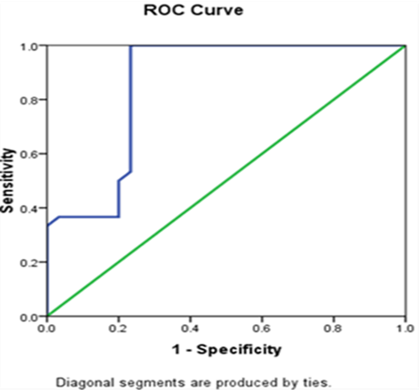Abstract
To assess C reactive protein (CRP) in detecting type-II diabetes mellitus with nephropathy. Patients with a history of diabetes type 2 with nephropathy and patients with diabetes type 2 without nephropathy were included in the study. A total of 30 cases, both male and female, were recruited and compared with30 normal healthy adults. Each participant (age, gender, BMI, i.e. body mass index and WHR, i.e. waist-hip ratio) were recorded. CRP was measured by immunoturbidimetric method. Total cholesterol, triglycerides, and high-density lipoprotein (HDL) cholesterol were measured by the CHOD- POD method, GPO-PAP method, and CHOD-POD/phosphotungstic method. Low-density lipoprotein (LDL)cholesterol and very low-density cholesterol were measured by Friedewald formula. Lipoprotein ratios ware also calculated. CRP was significantly (p=0.0001) higher among cases (12.60 3.30) compared to controls (5.47 4.29). CRP >9.5 correctly (efficacy) predicted DM2 with DN among 46.7% cases with sensitivity and specificity of 93.3 (95%CI=84.4-102.3) and 76.7 (95%CI=61.5-91.8) respectively. The area under the curve (AUC) was also high (AUC=0.85, 95%CI=0.75-0.95). There was a poor correlation of CRP with lipid profile among DM-2 with DN. Linear regression analysis showed that lipid biomarkers such as HDL, LDL, VLDL & total cholestarol-to-HDL ratio as well as BMI and WHR were positive predictors of CRP after adjusted for age and sex. In turn, HDL, LDL, VLDL and TC to HDL ratio level were a negative predictive factor of CRP levels. The increase of 1 unit on HDL was associated with a reduction of 1.25 in CRP levels. In this study, the level of CRP was higher among cases compared to controls. This study also found that CRP >9.5 had good sensitivity and specificity in predicting DM2 with DN.
Full text article
References
Ahmed, H. H., et al. 2017. Clinical significance of procalcitonin and c-reactive protein in the prediction of cardiovascular complications in patients with type 2 diabetes mellitus. Asian Journal of Pharmaceutical and Clinical Research, 10(9):297–306.
Belfki, H., et al. 2012. Association Between C- Reactive Protein and Type 2 Diabetes in a Tunisian Population. Inflammation, 35(2):684–689.
Couser, W. G., et al. 2011. The contribution of chronic kidney disease to the global burden of major noncommunicable diseases. Kidney International, 80(12):1258–1270.
Fiseha, T. 2015. Urinary biomarkers for early diabetic nephropathy in type 2 diabetic patients. Biomarker Research, 3(1):1–7.
Grunfeld, C., Feingold, K. R. 1996. Regulation of lipid metabolism bycytokines during host defense. Nutrition, 12(1):S24–S26.
Guha, M., et al. 2000. Molecular Mechanisms of Tumor Necrosis Factor α Gene Expression in Monocytic Cells via Hyperglycemia-induced Oxidant Stress-dependent and -independent Pathways. Journal of Biological Chemistry, 275(23):17728–17739.
Gussekloo, J., et al. 2000. C-Reactive Protein Is a Strong but Nonspecific Risk Factor of Fatal Stroke in Elderly Persons. Arteriosclerosis, Thrombosis, and Vascular Biology, 20(4):1047–1051.
Hirschfield, G. M., Pepys, M. B. 2003. C-reactive protein and cardiovascular disease: new insights from an old molecule. QJM: An International Journal of Medicine, 96(11):793–807.
Lee, S. Y., Choi, M. E. 2015. Urinary biomarkers for early diabetic nephropathy: beyond albuminuria. Pediatric Nephrology, 30(7):1063–1075.
Looker, H. C., et al. 2015. Biomarkers of rapid chronic kidney disease progression in type 2 diabetes. Kidney International, 88(4):888–896.
Morohoshi, M., et al. 1996. Glucose-dependent interleukin 6 and tumor necrosis factor production by human peripheral blood monocytes in vitro. Diabetes, 45(7):954–959.
Mussap, M., et al. 2002. Cystatin C is a more sensitive marker than creatinine for the estimation of GFR in type 2 diabetic patients. Kidney International, 61(4):1453–1461.
Pepys, M. B., Hirschfield, G. M. 2003. C-reactive protein: a critical update. Journal of Clinical Investigation, 111(12):1805–1812.
Ridker, P. M. 2003. Cardiology Patient Page. C- reactive protein: A simple test to help predict the risk of heart attack and stroke. Circulation, 108(12):e81–e85.
Volanakis, J. 2001. Human C-reactive protein: expression, structure, and function. Molecular Immunology, 38(2-3):189–197.
Wanner, C., et al. 2002. Inflammation and cardiovascular risk in dialysis patients. Kidney International, 61(80):S99–S102.
Zacho, J., et al. 2010. C-reactive protein and all-cause mortality–the Copenhagen City Heart Study. European Heart Journal, 31(13):1624–1632.
Authors

This work is licensed under a Creative Commons Attribution-NonCommercial-NoDerivatives 4.0 International License.

